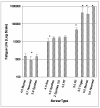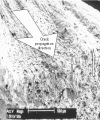Fatigue strength of common tibial intramedullary nail distal locking screws
- PMID: 19371438
- PMCID: PMC2672078
- DOI: 10.1186/1749-799X-4-11
Fatigue strength of common tibial intramedullary nail distal locking screws
Abstract
Background: Premature failure of either the nail and/or locking screws with unstable fracture patterns may lead to angulation, shortening, malunion, and IM nail migration. Up to thirty percent of all unreamed nail locking screws can break after initial weight bearing is allowed at 8-10 weeks if union has not occurred. The primary problem this presents is hardware removal during revision surgery. The purposes of our study was to evaluate the relative fatigue resistance of distal locking screws and bolts from representative manufacturers of tibial IM nail systems, and develop a relative risk assessment of screws and materials used. Evaluations included quantitative and qualitative measures of the relative performance of these screws.
Methods: Fatigue tests were conducted to simulate a comminuted fracture that was treated by IM nailing assuming that all load was carried by the screws. Each screw type was tested ten times in a single screw configuration. One screw type was tested an additional ten times in a two-screw parallel configuration. Fatigue tests were performed using a servohydraulic materials testing system and custom fixturing that simulated screws placed in the distal region of an appropriately sized tibial IM nail. Fatigue loads were estimated based on a seventy-five kilogram individual at full weight bearing. The test duration was one million cycles (roughly one year), or screw fracture, whichever occurred first. Failure analysis of a representative sample of titanium alloy and stainless steel screws included scanning electron microscopy (SEM) and quantitative metallography.
Results: The average fatigue life of a single screw with a diameter of 4.0 mm was 1200 cycles, which would correspond roughly to half a day of full weight bearing. Single screws with a diameter of 4.5 mm or larger have approximately a 50 percent probability of withstanding a week of weight bearing, whereas a single 5.0 mm diameter screw has greater than 90 percent probability of withstanding more than a week of weight bearing. If two small diameter screws are used, our tests showed that the probability of withstanding a week of weight bearing increases from zero to about 20 percent, which is similar to having a single 4.5 mm diameter screw providing fixation.
Conclusion: Our results show that selecting the system that uses the largest distal locking screws would offer the best fatigue resistance for an unstable fracture pattern subjected to full weight bearing. Furthermore, using multiple screws will substantially reduce the risk of premature hardware failure.
Figures






Similar articles
-
Fatigue performance of angle-stable tibial nail interlocking screws.Int Orthop. 2013 Jan;37(1):113-8. doi: 10.1007/s00264-012-1633-3. Epub 2012 Aug 9. Int Orthop. 2013. PMID: 22875484 Free PMC article.
-
Immediate weight-bearing after treatment of a comminuted fracture of the femoral shaft with a statically locked intramedullary nail.J Bone Joint Surg Am. 1999 Nov;81(11):1538-44. doi: 10.2106/00004623-199911000-00005. J Bone Joint Surg Am. 1999. PMID: 10565645
-
Effect of distal interlocking screw number and position after intramedullary nailing of distal tibial fractures: a biomechanical study simulating immediate weight-bearing.J Orthop Trauma. 2015 Feb;29(2):98-104. doi: 10.1097/BOT.0000000000000195. J Orthop Trauma. 2015. PMID: 25072288
-
Fatigue strength of locking screws and prototypes used in small-diameter tibial nails: a biomechanical study.J Trauma. 1999 Aug;47(2):379-84. doi: 10.1097/00005373-199908000-00030. J Trauma. 1999. PMID: 10452477
-
In situ SEM fatigue testing technology for metallic materials: a review.Nanoscale. 2024 Jul 18;16(28):13300-13330. doi: 10.1039/d4nr01568a. Nanoscale. 2024. PMID: 38965862 Review.
Cited by
-
Peri-implant fracture of the distal tibia after intra-medullary nailing of a tibial fracture: a report of two cases.Eur J Orthop Surg Traumatol. 2013 Nov;23 Suppl 2:S279-83. doi: 10.1007/s00590-012-1066-0. Epub 2012 Aug 11. Eur J Orthop Surg Traumatol. 2013. PMID: 23412198
-
The best location for proximal locking screw for femur interlocking nailing: A biomechanical study.Indian J Orthop. 2016 Jan-Feb;50(1):94-8. doi: 10.4103/0019-5413.173508. Indian J Orthop. 2016. PMID: 26955183 Free PMC article.
-
Fatigue performance of angle-stable tibial nail interlocking screws.Int Orthop. 2013 Jan;37(1):113-8. doi: 10.1007/s00264-012-1633-3. Epub 2012 Aug 9. Int Orthop. 2013. PMID: 22875484 Free PMC article.
-
Intercalary allograft reconstructions using a compressible intramedullary nail: a preliminary report.Clin Orthop Relat Res. 2010 Sep;468(9):2507-13. doi: 10.1007/s11999-010-1260-5. Epub 2010 Feb 10. Clin Orthop Relat Res. 2010. PMID: 20146034 Free PMC article.
-
Subtrochanteric fractures after retrograde femoral nailing.World J Orthop. 2015 Oct 18;6(9):738-43. doi: 10.5312/wjo.v6.i9.738. eCollection 2015 Oct 18. World J Orthop. 2015. PMID: 26495251 Free PMC article.
References
-
- Nicoll EA. Fractures of the Tibial Shaft. A Survey of 705 Cases. J Bone Joint Surg Br. 1964:373–87. - PubMed
-
- Haines JF, Williams EA, Hargadon EJ, Davies DR. Is conservative treatment of displaced tibial shaft fractures justified? J Bone Joint Surg Br. 1984;66:84–8. - PubMed
-
- Sarmiento A. A functional below-the-knee brace for tibial fractures. A report on its use in one hundred thirty-five cases. J Bone Joint Surg Am. 1970;52:295–311. - PubMed
LinkOut - more resources
Full Text Sources

